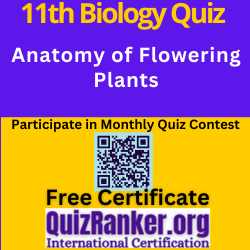Test your knowledge with our Anatomy of Flowering Plants MCQ Test for 11th Biology Chapter 6. This MCQ Test covers plant tissues, cell structures, and internal organ arrangements to help you grasp flowering plant anatomy.
Attempt Anatomy of Flowering Plants MCQ Test
Must Attempt Chapter wise 11th biology MCQ Test and Monthly Quiz contest of Biology 11th grade.
Brief for Anatomy of Flowering Plants MCQ Test
Plants are made up of different types of tissues classified into meristematic (apical, lateral, and intercalary) and permanent (simple and complex) tissues. These tissues perform functions such as food assimilation and storage, water and mineral transport, and providing mechanical support.
There are three main tissue systems:
- Epidermal Tissue System: Composed of epidermal cells, stomata, and epidermal appendages.
- Ground Tissue System: Makes up the bulk of the plant and includes the cortex, pericycle, and pith.
- Vascular Tissue System: Consists of xylem and phloem, which form vascular bundles that transport water, minerals, and food.
Monocotyledonous and dicotyledonous plants differ in the type, number, and location of their vascular bundles. Most dicotyledonous plants also undergo secondary growth in their roots and stems.
Chapter wise biology 11th grade mcq
Chapter 1 The Living World MCQ Test
Chapter 2 Biological Classification MCQ Test
Chapter 3 Plant Kingdom MCQ Test
Chapter 4 Animal Kingdom MCQ Test
Chapter 5 Morphology of Flowering Plants MCQ Test
Chapter 6 Anatomy of Flowering Plants MCQ Test
Chapter 7 Structural Organisation in Animals MCQ Test
Chapter 8 Cell The Unit of Life MCQ Test
Chapter 9 Biomolecules MCQ Test
Chapter 10 Cell Cycle and Cell Division MCQ Test
Chapter 11 Photosynthesis in Higher Plants MCQ Test
Chapter 12 Respiration in Plants MCQ Test
Chapter 13 Plant Growth and Development MCQ Test
Chapter 14 Breathing and Exchange of Gases MCQ Test
Chapter 15 Body Fluids and Circulation MCQ Test
Chapter 16 Excretory Products and their Elimination MCQ Test
Chapter 17 Locomotion and Movement MCQ Test
Chapter 18 Neural Control and Coordination MCQ Test
Chapter 19 Chemical Coordination and Integration MCQ Test
Source for Study
Total Views: 31


